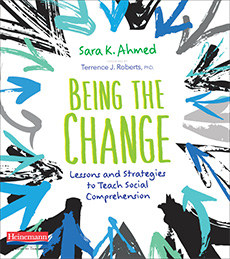Social Comprehension Helps Us Be the Change
Being the Change: Lessons and Strategies to Teach Social Comprehension
By Sara K. Ahmed
(Heinemann, 2018 – Learn more)

Turn on the news or plug in to social media and there is no question that our world needs kindness, compassion, tolerance, and understanding. The social issues impacting not only our lives but also the lives of our students are numerous.

Stretching my thinking and my comfort zone
Reading this book, I found that the ideas stretched my thinking. As a literacy educator, I read a lot of professional texts focused on teaching and improving instruction for literacy learners, but the topic of social comprehension is not one that I have delved into.
The book’s ideas are not only new to me, but also somewhat out of my comfort zone. When students have raised questions that are difficult to answer or broached topics that are sensitive, I have been guilty of steering the conversation in a different direction. In order to engage in the work of teaching social comprehension, these tough conversations are essential, and Ahmed forewarns us that they have the potential to lead to places of tension.
My thinking around these tough conversations has changed through reading this book. In the past, I have wanted to prevent my students from feeling any distress, but now I understand that these necessary conversations are powerful and can take place within a safe environment of trust and respect.
Understanding social comprehension
In the introduction, social comprehension is defined as “how we make meaning from and mediate our relationship with the world” (p. xxv). Ahmed argues in this section of the book that social comprehension is crucial if we want to further our society. In a diverse and challenging world, our students will be empowered if they have a deep knowledge of what is happening around them and have the ability to consider different ideas and perspectives.
The chapters of the book explore concepts related to teaching social comprehension with lessons that will engage students in conversations and expand on their understanding of the concepts.
The concepts discussed throughout the book are as follows:
- Chapter One includes lessons for engaging students in exploring their identities, which will help to set the stage for the social comprehension work that will follow.
- Chapter Two addresses ways to explicitly teach students to actively listen, facilitating more effective conversations.
- Chapter Three includes lessons to support students in understanding bias and how micro-agressions affect their lives and others.
- Chapter Four explores ways to support students as they share news of their lives and the world and reflect on how their identities influence their understanding of what is happening.
- Chapter Five focuses on understanding others with the goal to help students recognize their responsibility to others and empathize with other viewpoints.
- Chapter Six provides suggestions for addressing news events and crises that occur in our world with our students.
Detailed explanations for each lesson
There are one or more lessons in each of the chapters, one through five, to begin the work of teaching social comprehension. Within the lessons, Ahmed explains why the concept should be taught and when it’s useful to teach it. She also walks through each lesson step by step. The inclusion of language that she would use within the lessons helped me feel like I was in the classroom with Ahmed observing her teaching first-hand. There are also ideas for follow-up and suggestions for addressing challenges that may arise when teaching the lessons.
Thanks to the clear and detailed explanations, the lessons in this book are like a blueprint that teachers can follow even if they are new to teaching social comprehension. For teachers with experience teaching around social issues these lessons will provide inspiration for how to enhance and adapt instruction.
Although the publisher suggests this book for teachers of grades four through twelve, I think many of the ideas can be adapted for students in younger grades. Kristen Mraz, co-author of Kids First From Day One, has written a post on the Heinemann Blog about how one of the lessons from Being the Change was adapted for kindergarten.
Working through the book’s ideas with other educators
Ahmed suggests that before engaging our students in these lessons, teachers spend time working through them with colleagues. Through this prep work, teachers can gain experience with the types of conversations that will grow out of the lessons.
I had the opportunity to participate in a virtual book club in which a group of educators explored the ideas within Being the Change a few chapters at a time. Discussing this book with others helped me to deepen my understanding related to the teaching of social comprehension and become a more knowledgeable teacher. In addition, I am also beginning to refine my thinking about my own idea identity and how my perspective influences the ways in which I navigate the world.
Sarah K. Ahmed has written a book about enhancing professional knowledge, but it’s also one with heart. This book will inspire educators to think about ways in which their teaching can have an impact on making our world a more kind and compassionate place. Being the Change is practical, relevant, and insightful.
Dr. Lisa Maucione is a literacy specialist in Dartmouth, Massachusetts. She has presented professional development workshops related to literacy, both in her district and at professional conferences. Lisa is Vice President of the Massachusetts Reading Association. Her blog is Literacy On the Mind and her Twitter handle is @DrLMaucione.


































